iuniti eitchi Freedom of speech
1

2
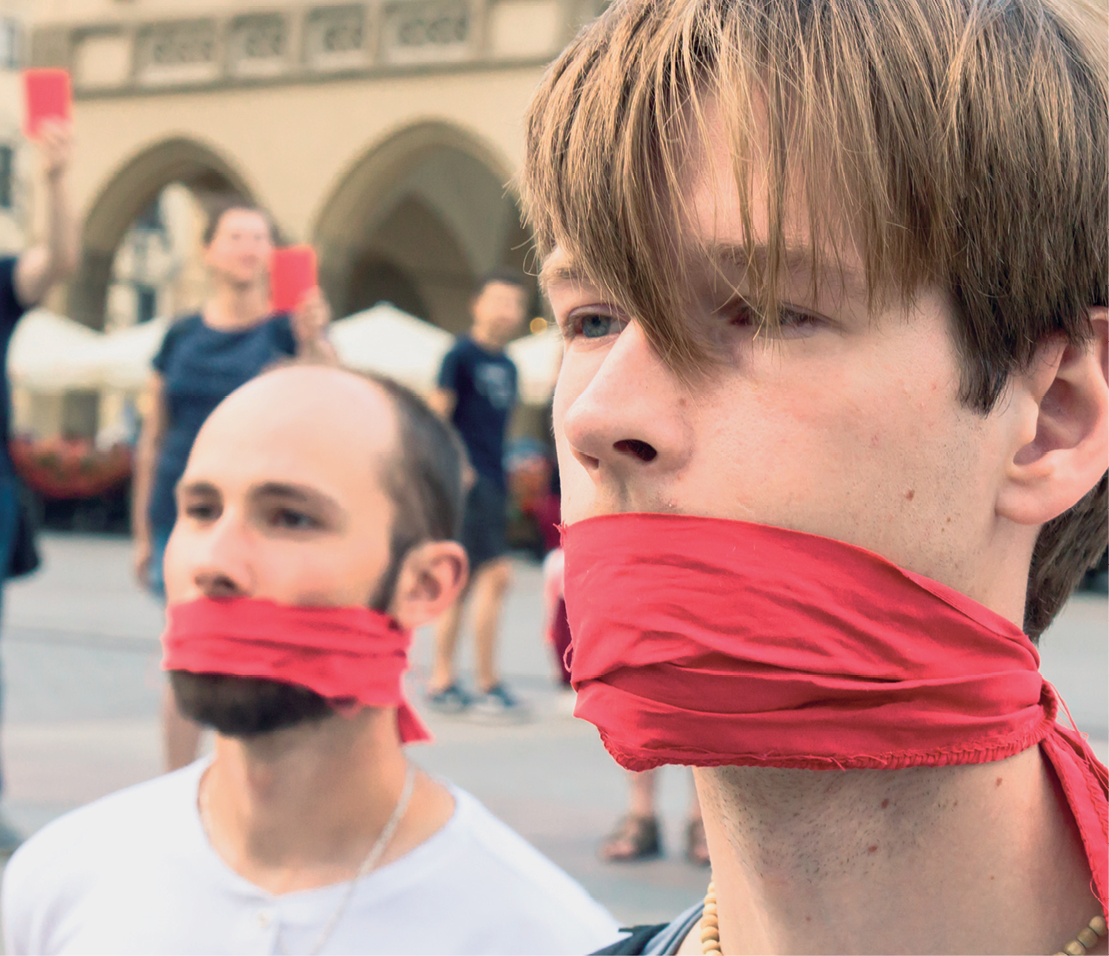
3
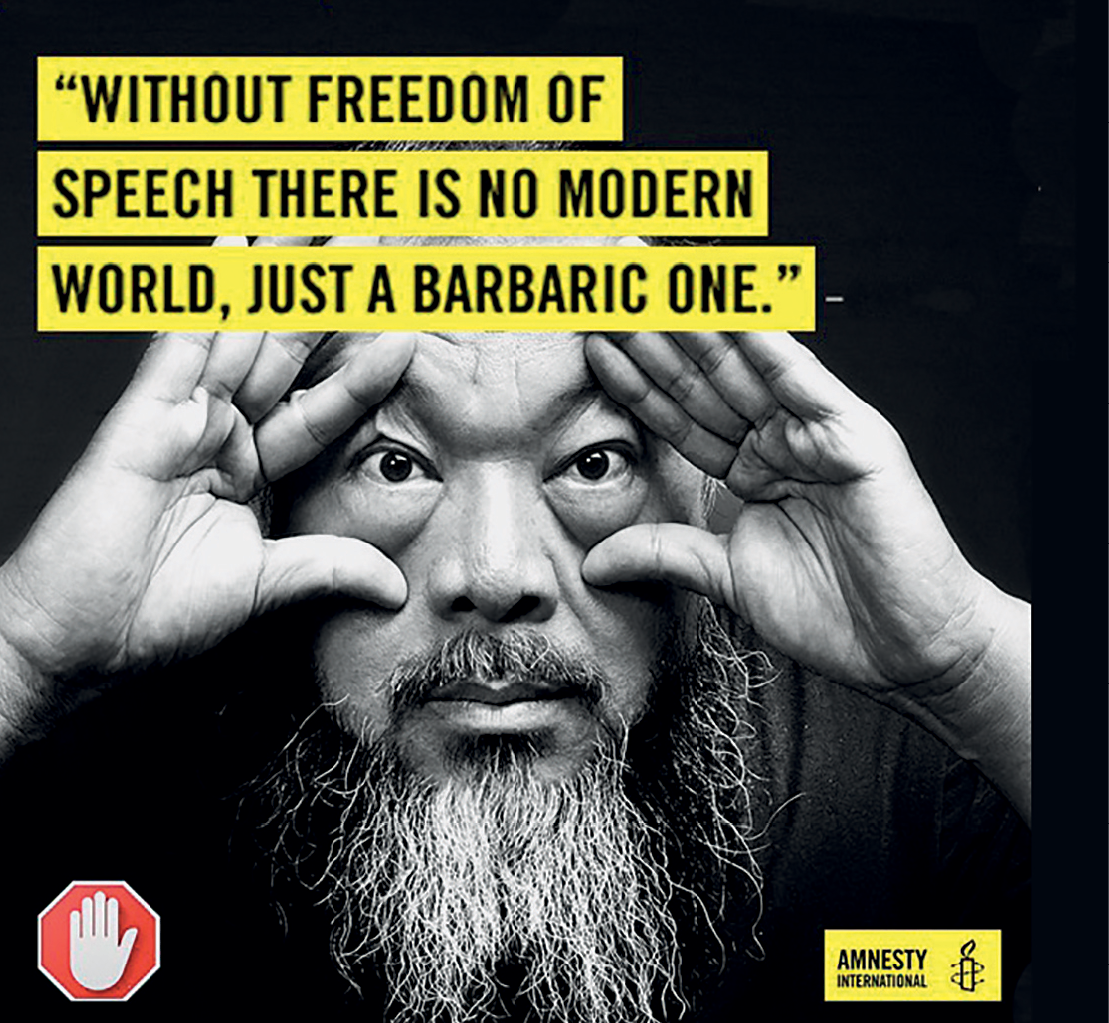
4
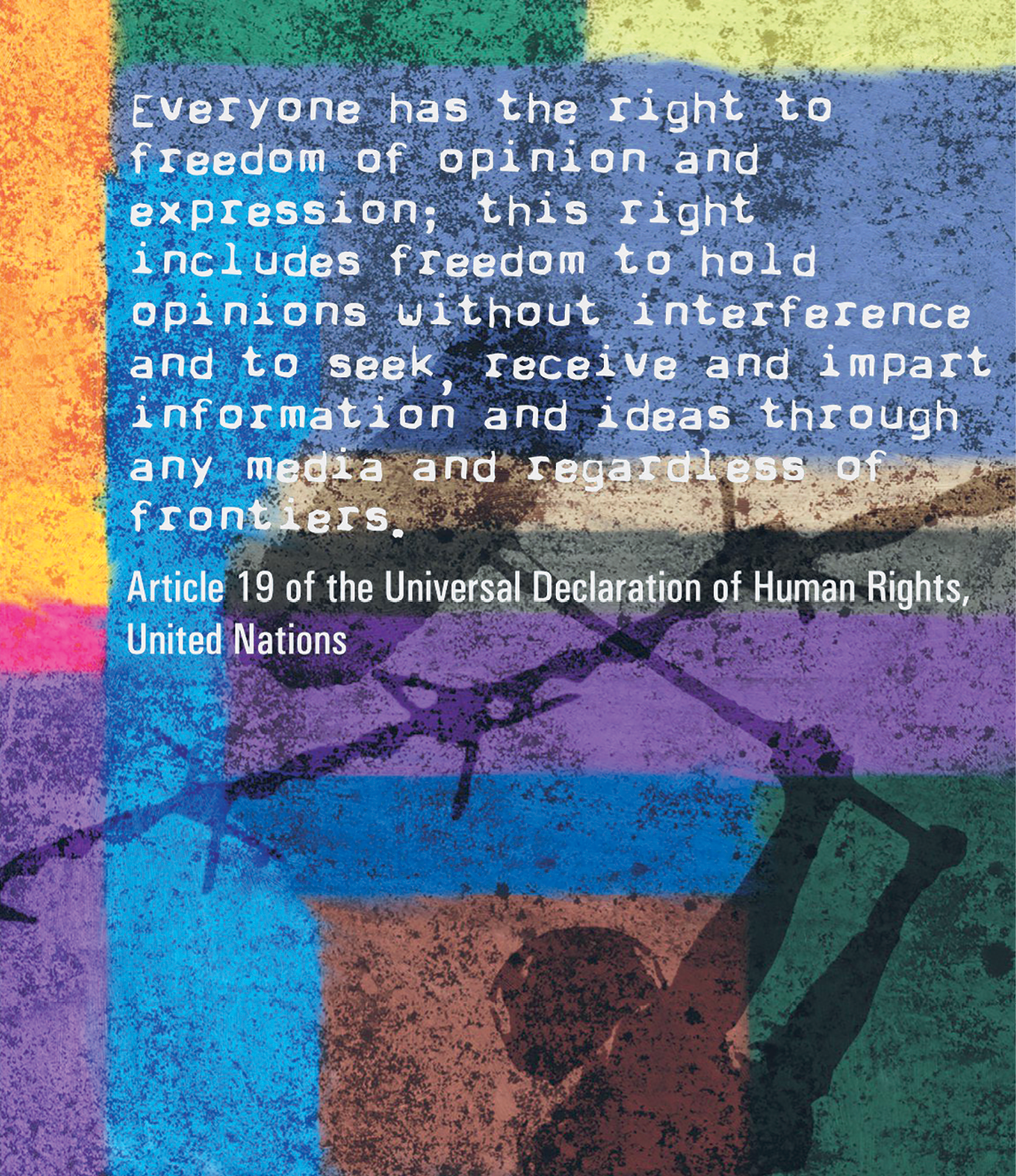
5
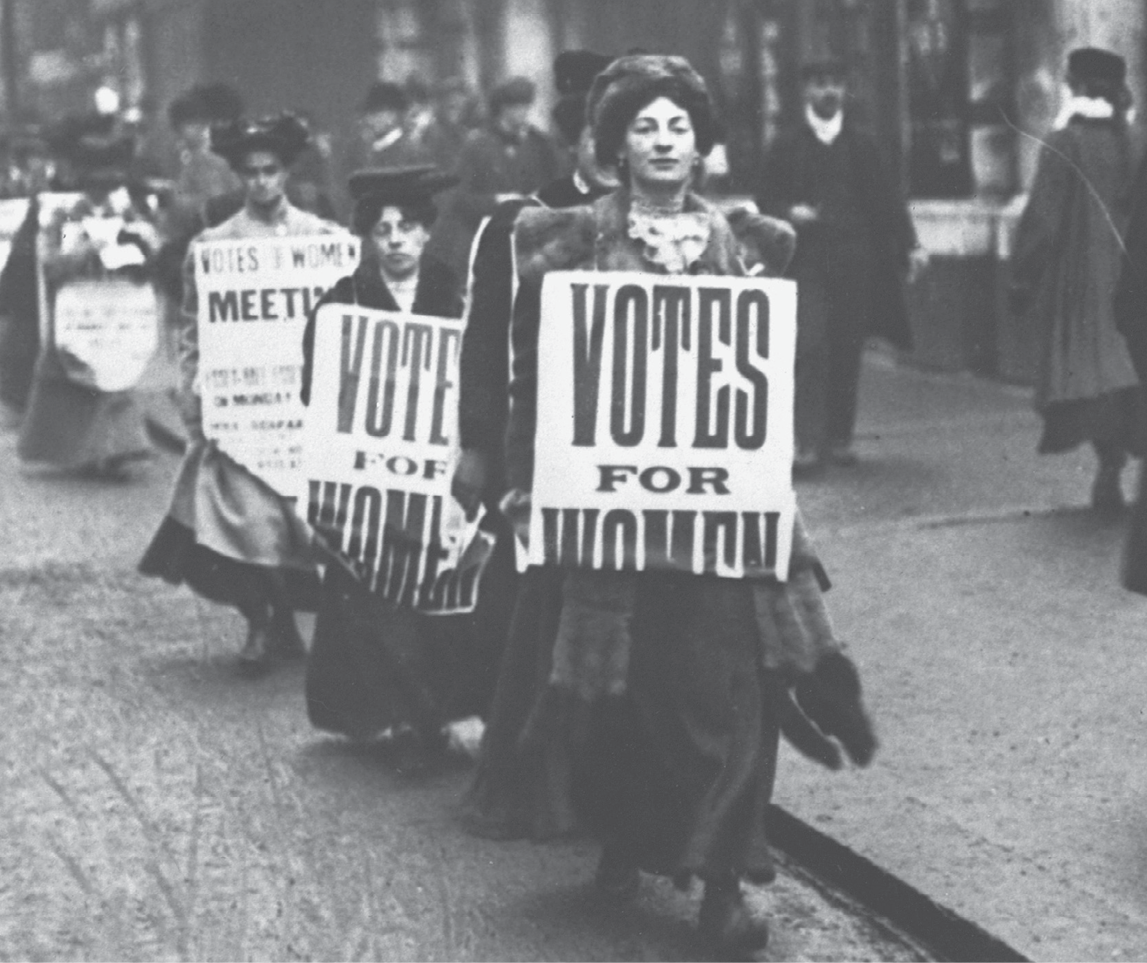
Respostas e comentários
Unit 8
Competências gerais e específicas desenvolvidas na unidade
A unidade pretende desenvolver as competências gerais 1, 2, 4, 5, 7, 8 e 9 e as competências específicas de Língua Inglesa 2, 3 e 4, que estão descritas na página trinta e um do Manual do Professor.
Habilidades desenvolvidas na unidade
ê éfe zero nove éle ih zero um / ê éfe zero nove éle ih zero três / ê éfe zero nove éle ih zero seis / ê éfe zero nove éle ih zero sete / ê éfe zero nove éle ih zero nove / ê éfe zero nove éle ih um zero / ê éfe zero nove éle ih um dois / ê éfe zero nove éle ih um três / ê éfe zero nove éle ih um cinco
Objetivo da unidade
A unidade introduz o tema “liberdade de expressão” e promove reflexões sobre o seu papel na formação de uma sociedade igualitária, na qual todos possam se expressar respeitosamente e pleitear seus direitos. Quanto aos itens linguísticos, a unidade aborda as orações condicionais do tipo 2. O tema aqui trazido permite realizar trabalhos interdisciplinares com História, no que tange a entender questões históricas que embasam a existência ou inexistência de liberdade de expressão nos países.
First interactions
Esta seção visa proporcionar uma discussão inicial sobre o nosso direito de expressar o que pensamos. Busca, também, estimular uma reflexão sobre a linha tênue que divide esse direito e as manifestações discursivas que incitam o ódio e a discriminação contra aqueles que têm uma visão de mundo diferente da nossa.
Objetivos
- Compreender e produzir um editorial escrito.
- Compreender o uso de orações condicionais do tipo 2 para falar de situações hipotéticas.
- Compreender posicionamentos orais em uma reunião/sessão deliberativa.
- Expressar opiniões, argumentar e contra-argumentar em uma reunião/sessão deliberativa.
- Identificar novas formas de escrita na constituição de mensagens digitais.
- Refletir sobre a liberdade de expressão de ideias e opiniões nos ambientes presenciais e virtuais, sobretudo nas redes sociais.
First interactions
- Discuss these questions with your classmates.
- What do you see in each picture?
- Which pictures show scenes that are happening outdoors? Have you seen similar events in your community, in your city or somewhere else in Brazil recently? If so, what were they about?
- Would you take part in any kind of freedom of speech march? Why (not)?
- In your opinion, which of these five pictures best represents the topic of this unit? Support your answer.

Agents of change
Throughout history, a lot of determined and courageous people used their freedom of speech to demand their rights, propose new forms of thinking and take a stand against injustices, like the women in picture 5. Discuss this topic by answering these questions:
- How important is it for citizens in any society to have this freedom and use it when necessary?
- What rights do we have today (in Brazil and in some other parts of the world) thanks to people who stood up, said what they thought and fought for their ideas in the past?
- How has freedom of speech been used in your community, in your city or in your country to try to change things for the better or to give voice to minority groups?
- Some critics argue that social media encourages users to use their freedom of speech to promote hate between groups that think differently from each other. Do you agree? Explain.
- In your opinion, how can we respectfully exercise the right to free speech online?
Respostas e comentários
1. a) Respostas possíveis: 1. A woman holding a placard in favor of freedom of speech. 2. Two people with their mouths covered in a public place to show passers-by that they are not free to speak. 3. A pôster ou tequist with Article 19 of the Universal Declaration of Human Rights. 4. A poster for a freedom of speech/free expression campaign. 5. Women protesting on the streets for their right to vote. Ver Notas.
1. b) Pictures 1, 2 and 5. Respostas pessoais. Ver Notas.
1. c) Respostas pessoais.
1. d) Respostas pessoais. Ver Notas.
Agents of change. Respostas pessoais. Ver Notas.
Agents of change. a) Respostas possíveis: If we are free to speak, we can protest against injustices, express our wishes and propose that those in power take action in order to change what we think is wrong.
b) Respostas possíveis: The right to freedom from slavery; the right for women to vote; the right to divorce; the right for women to report abuse from men; the right to work a certain number of hours; the right for minorities to enter college, etcétera
c) Resposta pessoal.
d) Respostas pessoais.
e) Respostas possíveis: By thinking about our words before posting them; by considering how we would feel if someone else used those words to say they disagree with what we defend; by avoiding both grim humor and prejudiced or offensive language.
Notas
Atividade 1 a professor ou professora, ao explorar a imagem 2, pode-se perguntar por que pessoas na Polônia fariam um protesto como esse. Sugere-se pedir aos ou às estudantes que pesquisem para saber as razões (Respostas possíveis: esses foram protestos contra uma lei que restringia a liberdade de imprensa na Polônia). Ao explorar a imagem 3 pode-se verificar o que sabem sobre a questão da liberdade de expressão nesse país acerca do uso da internet, que é o foco desta campanha da Anistia Internacional (Respostas possíveis: O uso de sites de busca na China é restrito, e os conteúdos publicados on-line são controlados.).
b professor ou professora, sugere-se explorar as imagens 1 e 5 perguntando aos ou às estudantes o que acham da prática de protestar usando cartazes em vias públicas.
dê professor ou professora, pode-se, aqui, explorar melhor a imagem 5, perguntando aos ou às estudantes se sabiam que, no passado, em muitos países, o direito ao voto era vetado às mulheres (em alguns países, ainda é). Sugere-se comentar que muito do que atualmente nos parece “natural”, como ir à escola, poder ir e vir, votar etcétera, é resultado do esforço de pessoas que, no passado, batalharam para alcançar esses direitos. Pode-se, então, explorar a Declaração Universal dos Direitos Humanos (imagem 3), perguntando aos ou às estudantes que tipos de direitos poderiam ser considerados de cunho universal, entendendo que isso pode esbarrar em questões culturais.
Informações adicionais
Krakow: Cracóvia, cidade polonesa que foi estabelecida como um dos inúmeros guetos de concentração de judeus durante a ocupação do país pela Alemanha no período do nazismo.
Article 19 of the Universal Declaration of Human Rights: artigo da Declaração Universal dos Direitos Humanos que trata especificamente da liberdade de expressão.
Ai Weiwei: artista e ativista social chinês conhecido pela resistência ao regime de seu país e pela defesa da liberdade de expressão.
Amnesty International: Anistia Internacional, organização não governamental que atua em mais de 150 países e que tem como objetivo a garantia dos direitos humanos.
Suffragettes: sufragistas, nome que receberam as mulheres de diversos países que, no final do século dezenove e início do vinte, lutaram por seu direito ao voto.
Reading
An editorial
Pre-reading
- What controversial stories have been in the news recently? What makes them controversial? Are there different views about it?
- Read this extract from a Canadian online newspaper and answer the questions in your notebook.
THE STAR
Opinion
Editorials
A turning point in the debate on free speech: Editorial
By STAR EDITORIAL BOARD
Tues., Nov. 21, 2017
A TURNING Point in the Debate on Free Speech: editorial. The Star, Toronto, 21 novembro 2017.Disponível em: https://oeds.link/16ZzRw. Acesso em: 10 maio 2022.
- In which newspaper section was this text published?
- Who wrote the article?
- Based on your answer in items “a” and “bê”, what do you expect to find in the text? Explain your choice.
- An objective and impartial news story about freedom of speech.
- The newspaper’s opinion on a news story about freedom of speech.
Reading
- Read the introduction of the editorial. Then choose the statement that is not true. Write the answer in your notebook.
- The editorial is going to express the newspaper’s opinion about a news story involving Wilfrid Laurier University and Lindsay Shepherd.
- Wilfrid Laurier University has always had the intention of starting a debate on freedom of expression.
- Wilfrid Laurier University didn’t approve of Lindsay Shepherd’s action.
- The newspaper board believes it is extremely necessary to debate freedom of expression.
Going further
The expression non-gendered pronouns refers to pronouns that don’t refer to a specific gender. For example, xe, ze or they are alternatives that have already been used at some universities to replace he and she.
Respostas e comentários
1. Respostas pessoais. Ver Notas.
2. a) In the Opinion ou Editorials section.
2. b) The editorial board/Star Editorial Board wrote it.
2. c) dois. Ver Notas.
3. b. Ver Notas.
Going further. Ver Notas.
Reading
O objetivo da seção é trabalhar as características do gênero editorial. Para isso, apresenta um editorial do jornal canadense The Star que questiona a liberdade de expressão nas universidades do país. As atividades trabalham as habilidades ê éfe zero nove éle ih zero seis: distinguir fatos de opiniões em textos argumentativos da esfera jornalística; e ê éfe zero nove éle ih zero sete: identificar argumentos principais e as evidências ou exemplos que os sustentam. Vale ressaltar que, nesta seção e no restante da unidade, foram escolhidos trechos de diferentes veículos de informação e que fica a seu critério explorar o posicionamento de cada um ou propor pesquisas sobre esses veículos e comparações com publicações do Brasil, fazendo uma análise contrastiva de como cada um aborda um mesmo tema da atualidade.
Notas
Atividade 1
professor ou professora, sugere-se explorar o conhecimento dos/as estudantes sobre algum assunto que tenha gerado polêmica nos noticiários do momento, perguntando o que sabem sobre ele, onde obtiveram as informações, quais são as diferentes opiniões etcétera Concentrar-se nisso é uma fórma de abordar o gênero editorial, texto que expressa o ponto de vista do meio de comunicação (jornal, revista etcétera) acerca do acontecimento. É importante fomentar uma atmosfera de respeito e tolerância ao longo de toda a discussão.
Atividade 2 c professor ou professora, espera-se que os ou as estudantes assinalem a segunda opção e respondam que isso se deve ao fato de que o texto foi escrito pelo conselho editorial do jornal – ou seja, por um grupo de pessoas que partilham da mesma opinião, que é a posição defendida pelo órgão que produz a notícia, e não por um ou umajornalista específico ou específica. Sugere-se, também, perguntar o que a turma já sabe sobre o gênero editorial, caso o tenha estudado nas aulas de Língua Portuguesa. A ideia é se basear nesse conhecimento prévio sobre o gênero para compará-lo com as características do mesmo gênero em língua inglesa.
Notas
Atividade 3 professor ou professora, recomenda-se estimular os ou as estudantes a explicar por que a opção do item “b” não é verdadeira. Espera-se que entendam que a palavra-chave é o advérbio “inadvertently” (inadvertidamente), utilizado no primeiro parágrafo. Ou seja, é incorreto afirmar que a universidade sempre teve a intenção de promover esse debate, visto que tudo ocorreu de forma não intencional. Sugere-se também pedir que expliquem por que a afirmação da opção “d” está correta (o editorial deixa claro que considera “muito necessário” esse debate ao afirmar, no segundo parágrafo, que ele é “badly needed” – nesse contexto, badly significa “muito”, “extremamente”).

THE STAR
A turning point in the debate on free speech: Editorial
By STAR EDITORIAL BOARD
Tues., Nov. 21, 2017
Wilfrid Laurier University may have inadvertently done a favour for anyone who values robust debate in the academic world.
By so badly bungling the case of Lindsay Shepherd, the teaching assistant who was hauled on the carpet for exposing her communications studies students to a discussion of the use of non-gendered pronouns, the university has opened the door to a badly needed debate on freedom of expression.

Wilfrid Laurier University masters student Lindsay Shepherd, who was censured for showing a video on the pros and cons on whether to use gender-neutral pronouns, in Ontario, Canada, 2017.
A TURNING Point in the Debate on Free Speech: editorial. The Star, Toronto, 21 novembro 2017. Disponível em: https://oeds.link/16ZzRw. Acesso em: 10 maio 2022.
Respostas e comentários
Acompanhando a aprendizagem
professor ou professora, para auxiliar na execução da atividade 1, sugere-se trazer exemplares de jornais recentes para que os ou as estudantes se familiarizem com as notícias que estão circulando na mídia, caso seja necessário. Sugere-se lembrar, também, que notícias controversas são aquelas que despertam no público posicionamentos diversos sobre o assunto. Pode-se perguntar quais mídias apoiam cada lado da história e por que o fazem, retomando, assim, discussões anteriores sobre o fato de diferentes grupos se posicionarem de acordo com suas próprias agendas e sobre a necessidade de o/a cidadão/cidadã crítico/a avaliar um evento sob diferentes ângulos antes de tomar partido, até mesmo para não propagar visões distorcidas ou falsas sobre os temas em pauta.
Going further
professor ou professora, se necessário, esclarecer que os pronomes neutros alternativos xe e ze não têm tradução para o português, diferentemente de they (eles/as). Em diferentes países, essas três formas são utilizadas como pronomes neutros. Após trabalhar com essa questão lexical, certificar-se de que os ou as estudantes tenham entendido outras expressões usadas no texto, como o verbo “bungle”. Pode-se enconrajá-los ou encorajá-las a inferir o sentido com base no contexto; todavia, se necessário, esclarecer que esse verbo significa “agir de uma forma desastrosa em relação a algo”. Já o advérbio “badly” reforça a ideia de falta de tato ao lidar com a situação, no caso, a situação envolvendo a professora-assistente Lindsay Shepherd. Pode-se também explorar a expressão “to be hauled/called on the carpet”, cujo significado é ser repreendido ou repreendida por ter feito algo supostamente errado.
4. Read the continuation of the editorial and choose the appropriate option to complete each statement. Find evidence in the text that supports your choices. Write the answers in your notebook.

THE STAR
[…] it’s so important to safeguard the role of universities as places that provide the maximum possible opportunity to exchange ideas and as spaces for those who would challenge conventional wisdom.
None of that was evident in how Shepherd was treated. As has been extensively reported, she played a clip […] featuring two University of Toronto professors debating the use of non-gendered pronouns. One of them, Jordan Peterson, objected to using them; the other, Nicholas Matte, supported it.
For that, Shepherd was disciplined […] for supposedly violating Wilfrid Laurier’s “Gendered and Sexual Violence” policy. She was told she had created a “toxic climate” for students and that exposing them to Peterson’s views was “transphobic.”
[…] Nonetheless, she managed bravely to defend what should be self-evident in a university environment: the value of hearing conflicting views on a controversial topic. […]
At the same time, those representing the university seemed to give no weight to the value of free debate. In fact, Shepherd’s view that she was presenting “both arguments” was seen as a problem, not a virtue. […] hearing Peterson might create an “unsafe learning environment” for some students.
This is reminiscent of the debates that have raged on university campuses for years […].
[…] At Dalhousie University in Halifax last month, for example, the usual roles were reversed when Masuma Khan, an activist and student union executive, was called before a disciplinary committee for supposedly attacking white people on social media and engaging in so-called “reverse racism.”
[…] Khan’s allies […] were vigorously standing up for her right to exercise free speech — and quite rightly so. Faced with massive pushback, Dalhousie […] dropped the case. The university came out for Khan’s right to speak her mind […].
At Wilfrid Laurier, too, there has been a change of mind, and hopefully a change of heart as well.
On Tuesday, the university’s president and vice-chancellor, Deborah MacLatchy, apologized to Shepherd for the way she was treated. More importantly, she reaffirmed the university’s commitment to “the abiding principles of freedom of speech and freedom of expression.” […]
If the debacle at Wilfrid Laurier kicks off that discussion, it may be seen in retrospect as the moment when a much healthier balance was restored in academia.
A TURNING Point in the Debate on Free Speech: editorial. The Star, Toronto, 21 novembro 2017. Disponível em: https://oeds.link/8aLw0F. Acesso em: 10 maio 2022.
Respostas e comentários
professor ou professora, os destaques no texto foram adicionados para a realização da atividade 5.
Acompanhando a aprendizagem
professor ou professora, após a realização da atividade 4, pode-se propor aos ou às estudantes que produzam uma definição para a expressão “turning point”, presente no título. Poderão inferir o significado com base em tudo que leram ou consultar dicionários. Outra opção é registrar no quadro duas alternativas para que escolham a que melhor se aplica. Por exemplo: 1. a “turning point”is a time at which an inconclusive change in a certain situation occurs; 2. a “turning point” is a time at which a determining change in a situation happens, mainly one with favorable results. (Resposta mais apropriada: 2.). Após a correção, sugere-se retomar as ideias principais do texto e relacionar essa ênfase que o editorial confere ao assunto desde o título, com a afirmação do item “d” da atividade 3 (The newspaper board believes it is extremely necessary to debate freedom of expression.).
Acompanhando a aprendizagem
professor ou professora, uma maneira de tornar a realização da atividade 4 mais acessível é organizar os ou as estudantes em seis grupos e atribuir um item para cada grupo. Nesse caso, cada grupo poderia analisar com mais atenção o texto e concentrar-se apenas na sua tarefa. Ao final, todos os grupos compartilhariam suas respostas e fariam uma apreciação geral das ideias principais do texto. Em vez de seis grupos, pode-se, também, organizar a turma em três grupos e atribuir dois itens a cada um.
- The authors believe universities must/must nót allow people to express ideas that are different from what the majority thinks.
- Lindsay Shepherd exposed her students to academic/non-academic opinions about the use of non-gendered pronouns.
- One of these opinions was interpreted/was not interpreted as offensive, violating the Wilfrid Laurier’s “Gendered and Sexual Violence” policy.
- The right to speak one’s mind is a difficult issue only on Wilfrid Laurier University campus/in different university campuses.
- Similarly to/Differently from Dalhousie University, Wilfrid Laurier University has dropped the case, that is, has brought it to an end.
- According to the last paragraphs of the editorial, the case of Lindsay Shepherd can/can’t have a positive result if the “debacle” (fiasco) at Wilfrid “kicks off” (starts) the discussion about freedom of speech and freedom of expression in universities.
- Read the editorial in activity 4 again and choose the options that are true. Write the answers in your notebook.
- The highlighted excerpts in the text express espaço para resposta.
- facts (what happened)
- opinions (what the authors think about the case)
- facts and opinions
- The highlighted excerpts in the text express espaço para resposta.
Versão adaptada acessível
Atividade 5, item a.
a The following excerpts in the text express <espaço para completar>.
I facts (what happened)
II opinions (what the authors think about the case)
III facts and opinions
Excerpts:
“[…] she played a clip […] featuring two University of Toronto professors debating the use of non-gendered pronouns. One of them, Jordan Peterson, objected to using them; the other, Nicholas Matte, supported it.”
“[…] Shepherd was disciplined […] for supposedly violating Wilfrid Laurier’s ‘Gendered and Sexual Violence’ policy. She was told she had created a “toxic climate” for students and that exposing them to Peterson’s views was ‘transphobic.’”
“[…] Shepherd’s view that she was presenting ‘both arguments’ was seen as a problem, not a virtue. […] hearing Peterson might create an ‘unsafe learning environment’ for some students. This is reminiscent of the debates that have raged on university campuses for years”.
“At Dalhousie University in Halifax last month, for example, the usual roles were reversed when Masuma Khan, an activist and student union executive, was called before a disciplinary committee for supposedly attacking white people on social media and engaging in so-called ‘reverse racism’.”
“Khan’s allies […] were vigorously standing up for her right to exercise free speech […]. Faced with massive pushback, Dalhousie […] dropped the case. The university came out for Khan’s right to speak her mind […]. At Wilfrid Laurier, too, there has been a change of mind”
“On Tuesday, the university’s president and vice-chancellor, Deborah MacLatchy, apologized to Shepherd for the way she was treated. […] she reaffirmed the university’s commitment to ‘the abiding principles of freedom of speech and freedom of expression’.”
- The editorial mentions facts in order to provide espaço para resposta.
- a summary of the case and evidence that supports the authors’ view
- a neutral position on the subject
- different opinions on the subject
- The main argument of the editorial consists in expressing that espaço para resposta.
- things have finally changed for those who speak their minds on campuses
- universities must engage in serious debate on free speech
- people don’t know how to speak their minds on many campuses
Post-reading
- Discuss these questions with your classmates.
- What is your opinion about the case of Lindsay Shepherd?
- How can we draw a line between exercising our right to express ourselves and the respect we must have for those who think differently from us?
- Have you ever been reprimanded by seiing ór pôstin something that others disagreed with? If so, share your experience.
- How do you normally react when your friends post things you disagree with?
- When was the last time you read a post that you considered disrespectful? What was it about?
Respostas e comentários
4. professor ou professora, os excertos foram suprimidos no livro por restrição de espaço, mas espera-se que os ou as estudantes utilizem-nos sem supressão.
4. a) must. “reticências it’s so important […] conventional wisdom.”; “reticências what should be self-evident […] controversial topic.”
4. b) academic. “reticências she played a clip reticências featuring two University of Toronto professors debating the use of non-gendered pronouns.”
4. c) was interpreted. “reticências Shepherd was disciplined […] exposing them to Peterson’s views was ‘transphobic.’”
4. d) in different university campuses. “This is reminiscent of the debates that have raged on university campuses for years.”; “reticências At Dalhousie University […], for example reticências.”
4. e) Similarly to. “reticências Dalhousie […] dropped the case. […] At Wilfrid Laurier, too, there has been a change of mind […].”
4. f) can. “If the debacle at Wilfrid Laurier kicks off that discussion, it may be seen in retrospect as the moment when a much healthier balance was restored in academia.”
5. a) um.
5. b) um.
5. c) dois.
6. Respostas pessoais. Ver Notas.
Notas
Atividade 6 professor ou professora, se julgar pertinente, registrar no quadro a seguinte citação de Martin Luther King Júnior (1929-1968), líder do movimento pelos direitos civis nos Estados Unidos, a fim de inspirar os ou as estudantes a discutir o assunto e embasar a opinião expressa pelo editorial sobre o caso de Lindsay Shepherd: “Let us not seek to satisfy our thirst for freedom by drinking from the cup of bitterness and hatred.” [Não busquemos satisfazer nossa sede por liberdade bebendo do copo da amargura e do ódio.] (“I Have a Dream”, discurso proferido em 28 de agosto de 1963, na Marcha de Washington D.C., Estados Unidos).
Informações adicionais
Wilfrid Laurier University: universidade pública em Waterloo, Ontário, Canadá.
Jordan Peterson: psicólogo, professor e escritor canadense.
Nicholas Matte: acadêmico canadense dedicado aos estudos sôbre diversidade sexual.
Dalhousie University: universidade pública, na província de Nova Escócia, no Canadá.
Reverse racism: termo por meio do qual se pretende defender que as ações afirmativas e programas antirracistas, tanto por parte do govêrno como por parte de organizações privadas, constituem, também, uma forma de racismo contra os brancos perpetrado pelos grupos minoritários. Os opositores ao conceito de “reverse racism”, por sua vez, afirmam que as minorias não têm poder para atacar a maioria, não havendo, dessa forma, fundamentação para a afirmação de que exista o “racismo reverso”.
fóra da sala de aula
professor ou professora, pode-se fazer um trabalho interdisciplinar com Língua Portuguesa, solicitando aos ou às estudantes que escolham um tema internacional que esteja repercutindo amplamente na mídia. Em seguida, enconrajá-los ou encorajá-las a procurar editoriais em jornais no Brasil e no exterior que tratem do assunto. A ideia é ler esses editoriais e comparar a construção da argumentação em português com a construção da argumentação em inglês, procurando semelhanças e diferenças. Outra possibilidade de trabalho é investigar quais opiniões vêm sendo veiculadas e o que têm em comum/diferente entre si, de acordo com a orientação de cada canal de informação. Espera-se que essa atividade contribua para o desenvolvimento de uma visão crítica dos posicionamentos da mídia, entendendo que estes costumam estar alinhados com os interesses de cada grupo.
lenguage in iusi uon
Conditional sentences – type 2
1. Read this news extract. How can this situation represent a threat to free speech?
WEB CENSORSHIP: THE NET IS CLOSING IN
Across the globe governments are monitoring and censoring access to the web. And if we’re not careful, millions more people could find the Internet fractured, fragmented and controlled by the state
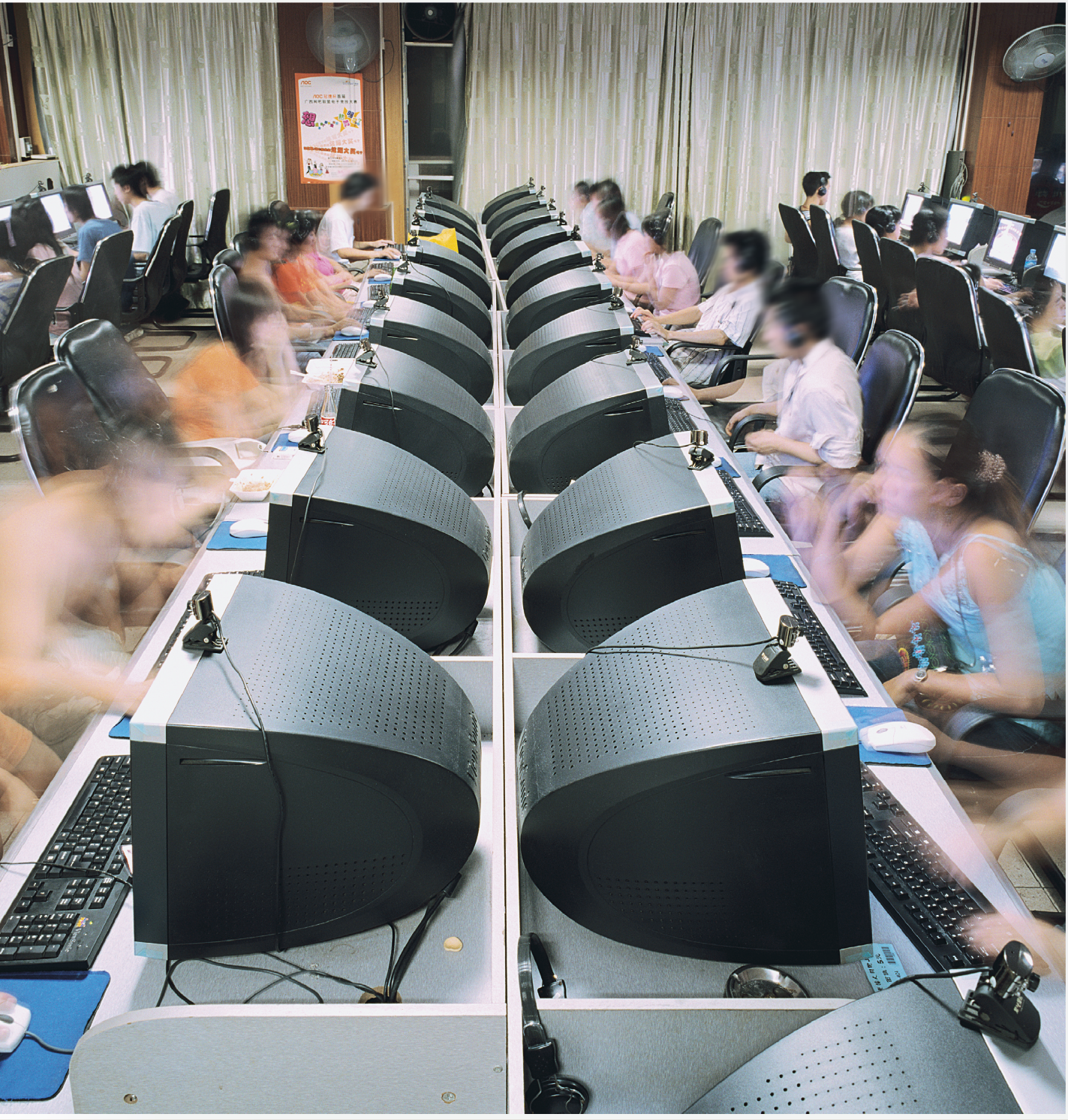
Customers at an internet cafe in Guilin, China, where the government places severe restrictions on web access.
SCHMIDT, Eric; COHEN, Jared. Web Censorship: The Net is Closing In. The Guardian,Londres, 23 abril 2013. Disponível em: https://oeds.link/ZJRWD1. Acesso em: 30 abril 2022.
Respostas e comentários
Language in use 1
O objetivo desta seção é trabalhar a habilidade ê éfe zero nove éle ih um cinco: empregar, de modo inteligível, as formas verbais em orações condicionais dos tipos 1 e 2 If-clauses – com foco na segunda condicional, ou condicional de tipo 2). Isso é feito com base no estudo de excertos de artigos sobre questões relacionadas à liberdade de expressão.
Notas
Atividade 1 professor ou professora, dependendo do que tiver sido discutido sobre a imagem 4 (campanha da Anistia Internacional mostrando o artista chinês Ai Weiwei) na abertura desta unidade, pode-se explorar melhor o trecho de uma matéria do The Guardian a fim de se aprofundar no assunto. Sugere-se chamar a atenção da turma para o ano de publicação do artigo (2013) e incentivá-la a buscar informações sobre a situação atual naquele país a respeito desse tipo de censura.
- Read these extracts from the article in activity 1 and from other articles about free speech. Are the scenarios real or imaginary? Support your answer.
![Quadro com texto:
“[…] (em amarelo) if your IP address (the unique number associated with each
device on the internet) came from a blacklisted country, (em azul) you would
encounter heightened monitoring. ”](../resources/images/im_0005_t_pea9_u08_f2_g24_reaproveitamento.png)
SCHMIDT, Eric; COHEN, Jared. Web Censorship: The Net is Closing In. The Guardian, Londres, 23 abril 2013. Disponível em: https://oeds.link/ZJRWD1. Acesso em: 30 abril 2022.
b.

SCHMIDT, Eric; COHEN, Jared. Web Censorship: The Net is Closing In. The Guardian, Londres, 23 abril 2013. Disponível em: https://oeds.link/ZJRWD1. Acesso em: 30 abril 2022.
c.
![Quadro com texto:
“No government has yet achieved an alternative system, but (em amarelo) if one succeeded in doing so, (em azul) it would eectively unplug its population from the global internet (sem destaque) and instead oer only a closed, national intranet. In technical terms, this would entail creating a censored gateway between a given country and the rest of the world […].”](../resources/images/im_0007_t_pea9_u08_f2_g24_reaproveitamento.png)
SCHMIDT, Eric; COHEN, Jared. Web Censorship: The Net is Closing In. The Guardian, Londres, 23 abril 2013. Disponível em: https://oeds.link/ZJRWD1. Acesso em: 30 abril 2022.
d.
![Quadro com texto:
“(em amarelo) If some member countries in the Commonwealth of Independent States […] became fed up with Moscow’s insistence on standardising the Russian language across the region, (em azul) they could join together to censor all Russian-language content from their national internets (sem destaque) and thus limit their citizens’ exposure to Russia.”](../resources/images/im_0008_t_pea9_u08_f2_g24_reaproveitamento.png)
SCHMIDT, Eric; COHEN, Jared. Web Censorship: The Net is Closing In. The Guardian, Londres, 23 abril 2013. Disponível em: https://oeds.link/ZJRWD1. Acesso em: 30 abril 2022.
e.

THE FREE Speech-Hate Speech Trade Off. The New York Times, Nova York, 13 setembro 2017. Disponível em: https://oeds.link/QrOEmg. Acesso em: 30 abril 2022.
Going further
Internet versus Intranet
Notice how the meaning of a word changes depending on the prefix used: intra- means “within,” “inside,” in the sense of “net inside one country” (Intranet), while inter- means “among,” “mutually,” in the sense of “net together with other countries” (Internet).
Respostas e comentários
2. Respostas possíveis: These scenarios are imaginary, because of the use of the conjunction “if” and expressions such as “others speculate that” (item “bê”) and “no government has yet achieved an alternative system” (item “cê”). Ver Notas.
Going further. Ver Notas.
Notas
Atividade 2 professor ou professora, antes de pedir aos ou às estudantes que façam esta atividade, recomenda-se revisar o conceito de oração condicional apresentado na Unidade 2 deste volume. A Unidade 2 concentrou-se em estabelecer uma relação entre uma condição e um resultado, envolvendo situações que são sempre verdadeiras, que normalmente acontecem ou podem acontecer. Pode-se preparar a turma para o novo assunto, solicitando-lhe alguns exemplos curtos e simples usando zero conditional (conditional sentences – type zero) e first conditional (conditional sentences – type 1).
fóra da sala de aula
professor ou professora, para promover um trabalho interdisciplinar com História e Geografia, pode-se solicitar uma pesquisa para entender melhor o tópico trazido pelo item “d” da atividade 2. Sugere-se solicitar aos ou às estudantes que pesquisem o que é a Commonwealth of Independent States (Comunidade dos Estados Independentes, em português), qual é a relação entre os países que fazem parte dela e quais são os motivos que levam a Rússia a insistir em padronizar o idioma na região. os ou as estudantes podem encontrar mais informações no próprio site da Commonwealth, disponível em: https://oeds.link/3BR9Wh (acesso em: 5 abril 2022). Após a realização da pesquisa, pedir aos ou às estudantes que compartilhem com os ou as colegas as informações que encontrarem e promover um debate sobre o tema.
Going further
professor ou professora, além da questão linguística sôbre os prefixos intra- e inter-, se julgar relevante, sugere-se chamar a atenção dos/as estudantes para a palavra standardising, no item “d” da atividade 2, e abordar as diferenças ortográficas do sufixo -ise/-ize. Sugere-se solicitar que elenquem outros verbos formados com esse sufixo, que, portanto, podem ter duas ortografias (modernise/modernize e legalise/ legalize, por exemplo) dependendo da variante de inglês adotada.
Versão adaptada acessível
Atividade
Study the extracts in activity 2 and answer the questions in your notebook.
a What clauses introduce imaginary conditions?
(a) if your IP address (the unique number associated with each device on the internet) came from a blacklisted country; (b) if it wasn’t able to build an alternative root system; (c) if one succeeded in doing so; (d) If some member countries in the Commonwealth of Independent States […] became fed up with Moscow’s insistence on standardising the Russian language across the region,; (e) If speech had no effects.
c What clauses introduce a possible, but imaginary, result of this condition?
(a) you would encounter heightened monitoring; (b) Iran could pioneer a dual-internet model; (c) it would e_ectively unplug its population from the global internet; (d) they could join together to censor all Russian-language content from their national internets; (e) it wouldn’t be a fundamental right.
- Study the extracts in activity 2 and answer the questions in your notebook.
- How many clauses are highlighted in each item?
- Which color is used to introduce imaginary conditions?
- Which color is used to introduce a possible, but imaginary, result of this condition?
- Study the extracts in activity 2 again and choose the appropriate options. Write the answers in your notebook.
- In the same way as in zero and first conditional (type 1), “if” is a conjunction that introduces espaço para resposta.
- conditions
- results
- Clauses that introduce imaginary present or future conditions contain espaço para resposta.
- a verb in the past (affirmative or negative)
- “would” (or “could”) + verb in the base form (affirmative, negative or interrogative)
- Clauses that express an imaginary result contain espaço para resposta.
- a verb in the past form (affirmative or negative)
- “would” (or “could”) + verb in the base form (affirmative, negative or interrogative)
- The negative full forms of “would” and “could” are formed by adding nót espaço para resposta.
- before “would” and “could”
- after “would” and “could”
- In the same way as in zero and first conditional (type 1), “if” is a conjunction that introduces espaço para resposta.
- Choose the appropriate options to complete this summary about second conditional clauses. Write the answers in your notebook.
To talk about imaginary situations in the present or future under certain conditions, we use if/unless/even if + subject + verb in the past tense/would + verb in the base form with the main clause formed by subject + verb in the past tense/would + verb in the base form.
Going further
Observe the sentence in:
“Wouldn’t that be nice if Earth were a peaceful place for everyone to live?”
This construction is possible only in second conditional sentences: if I were (or if I was), if he/she were (or if he/she was), if it were (or if it was). Were is most commonly used in more formal contexts, but both forms are correct.
6. Complete these clauses with the appropriate form of the verbs in the box. Then, in your notebook, finish the sentences with information about yourself.
can have lose meet wake up
- If I espaço para resposta only 24 hours to live, espaço para resposta.
- If I espaço para resposta my favorite singer, espaço para resposta.
- If I espaço para resposta be an animal, espaço para resposta.
- If I espaço para resposta rich one morning, espaço para resposta.
e. If I espaço para resposta my smartphone with lots of important information in it, espaço para resposta.
Respostas e comentários
3. a) Two.
3. b) Yellow.
3. c) Blue.
4. a) um.
4. b) um.
4. c) dois.
4. d) dois.
5. verb in the past tense; “would” + verb in the base form.
6. a) had. Respostas pessoais.
6. b) met. Respostas pessoais.
6. c) could. Respostas pessoais.
6. d) woke up. Respostas pessoais.
6. e) lost. Respostas pessoais.
Language in use 2
A seção busca expandir o conhecimento dos/as estudantes sobre a linguagem classificada como “internetês”. Trabalha-se a habilidade ê éfe zero nove éle ih um três: reconhecer, nos novos gêneros digitais (blogues, mensagens instantâneas, tweets, entre outros), novas formas de escrita (abreviação de palavras, palavras com combinação de letras e números, pictogramas, símbolos gráficos, entre outros) na constituição das mensagens.
Notas
Atividade 1
professor ou professora, como a troca de mensagens virtuais pode também ocorrer no meio de partidas de jogos on-line, sugere-se encorajar os ou as estudantes a compartilhar essas experiências com a turma. Ao explorar o item “c”, caso respondam que não têm como fazer a comparação porque não escrevem mensagens em papel, pode-se especular sobre a experiência de outras pessoas que escrevem recados, cartas, e-mails profissionais etcétera Recomenda-se registrar no quadro algumas frases que poderiam ser usadas em aplicativos de mensagens e perguntar aos ou às estudantes: “How would you rewrite these messages if you had to put these ideas on paper?”. Sugestões: “Where r u?” (Where are you?); “im ueitin 4 u” (I’m waiting for you.); “greiti talk 2 u leiter” (Great! Talk to you later.).
Atividade 3 professor ou professora, sugere-se rever o gênero microblog, estudado na Unidade 1 do volume do 8º ano, ou apresentar suas características, caso o tópico seja novo. Com base nos dois textos, pode-se perguntar o que a turma sabe sobre essa plataforma, com foco na limitação de caracteres (informação central para entender a razão por que as pessoas encurtam suas mensagens). Embora o volume de texto das mensagens apresentadas não permita obter uma ideia global sobre o assunto, é possível fazer inferências com base nas discussões que já vêm sendo feitas sobre liberdade de expressão nesta unidade.
Atividade 4 professor ou professora, sugere-se comentar que não há uma regra que regule a formação de termos do “internetês”; entretanto, pode-se informar que há alguns critérios que determinam as abreviações, sendo a pronúncia um deles, tanto que “ur” pode significar “you are” ou “your”, dependendo do contexto. Letras maiúsculas podem indicar tanto começo de frase como ênfase ao que se deseja escrever.
lenguage in iusi tchu
Internet language
undefined- Pseudo-acronym: espaço para resposta
- a sequence of characters (numbers, letters) that represents longer words with less typing.
- a small digital image or icon used to express an idea or emotion.
- a shortened form of a word or phrase that represents the complete form.
téquist uán

This is not government sitye. If u don’t like details, unfollow. U can stay in ur bubble but we have free speech. U don’t decide 4us.
7:20 PM – 2 Oct 2016

téquist tchú

Swara Bhasker
@ReallySwara
Follow
It is impressive that a manstream politician like @RahulGandhi is taking this clear & progressive stand on freedom of expression & censorship. Also it’s gracious & mature that he is able to set aside the personal for the large goal of democratic rights.
#CreditWhereDue
- wtv
- check
- I see
- whatever
- abáuti
- favorite
- to be honest
- I don’t know
- bifór
- face to face
- more to follow
- bicós
- by the way
Respostas e comentários
1. Ver Notas.
1. a) Resposta pessoal.
1. b) Respostas possíveis: Twitter, WhatsApp, Facebook, SMS, Messenger, etcétera
1. c) Resposta pessoal.
2. a) três.
2. b) dois.
2. c) um.
3. Ver Notas.
3. Text 1. Respostas possíveis: To disagree with the people who complain about the profile’s content and to claim we have free speech.
3. Text 2. Respostas possíveis: To agree and congratulate a politician on his attitude toward freedom of speech.
4. Text 1: Abbreviation (the use of “u” in place of “you”, “U” in place of “You” and “ur” in place of “your”) and pseudo-acronym (the use of “4us” in place of “for us”). Text 2: abbreviation (the use of “&” in place of “and”) and emoji (the use of the clapping hands emoji to express approval or appreciation of someone else’s post). Ver Notas.
5. a) quatro
5. b) onze
5. c) oito
5. d) doze
5. e) um
5. f) nove
5. g) cinco
5. h) dois
5. i) sete
5. j) dez
5. k) seis
5. l) três
6. Respostas pessoais. Ver Notas.
Notas
Atividade 6 professor ou professora, sugere-se explicar a diferença entre emojis e emoticons. Um emoticon, como o próprio nome sugere (emotion + icon), é um ícone que expressa emoções; um emoji pertence a uma biblioteca de figuras prontas que expressam ideias mais variadas. Para esta atividade, sugere-se encorajar os ou as estudantes a contemplar a diversidade étnica nas criações que retratarem figuras humanas. Essa dica se agrega à discussão sobre como a criação de outras expressões culturais, como cartuns, filmes, campanhas, séries etcétera, pode contribuir para que um maior número de pessoas em uma sociedade se sinta representado. Pode-se aproveitar a atividade para propor a criação de emojis/emoticons que expressem algum conceito atual importante.
Informações adicionais
Rahul Gandhi: político indiano que é bisneto do primeiro premiê da Índia logo depois da independência do Reino Unido e neto de Indira Gandhi. Apesar do sobrenome, não tem parentesco com o líder pacifista Mahatma Gandhi.
fóra da sala de aula
professor ou professora, sugere-se pedir aos ou às estudantes que assistam ao filme The Emoji Movie (Emoji: o filme), animação de 2017, e propor, ao final, uma apreciação da obra. Se o filme já foi assistido pelos ou pelas estudantes, conforme sugestão no volume do 6o ano desta obra, é possível retomar o assunto a partir da memória dos/as estudantes. Pode-se perguntar a eles/as de que partes mais gostaram, qual teria sido o objetivo dos/as criadores/as e o que mudariam no filme. A discussão pode abordar, também, as razões que levaram o cinema a produzir um filme sobre esse tipo de linguagem eletrônica.
lissenin
Expressing opinions and reaching a consensus
Pre-listening
- In your opinion, are universities free from intolerance and prejudice? Do you think different views live together in harmony on campuses?
- Look at this excerpt from an article. Answer the questions orally.
CAMPUS ADULTS, PROTECT FREESPEECH: OUR VIEW
The Editorial Board, USA TODAY
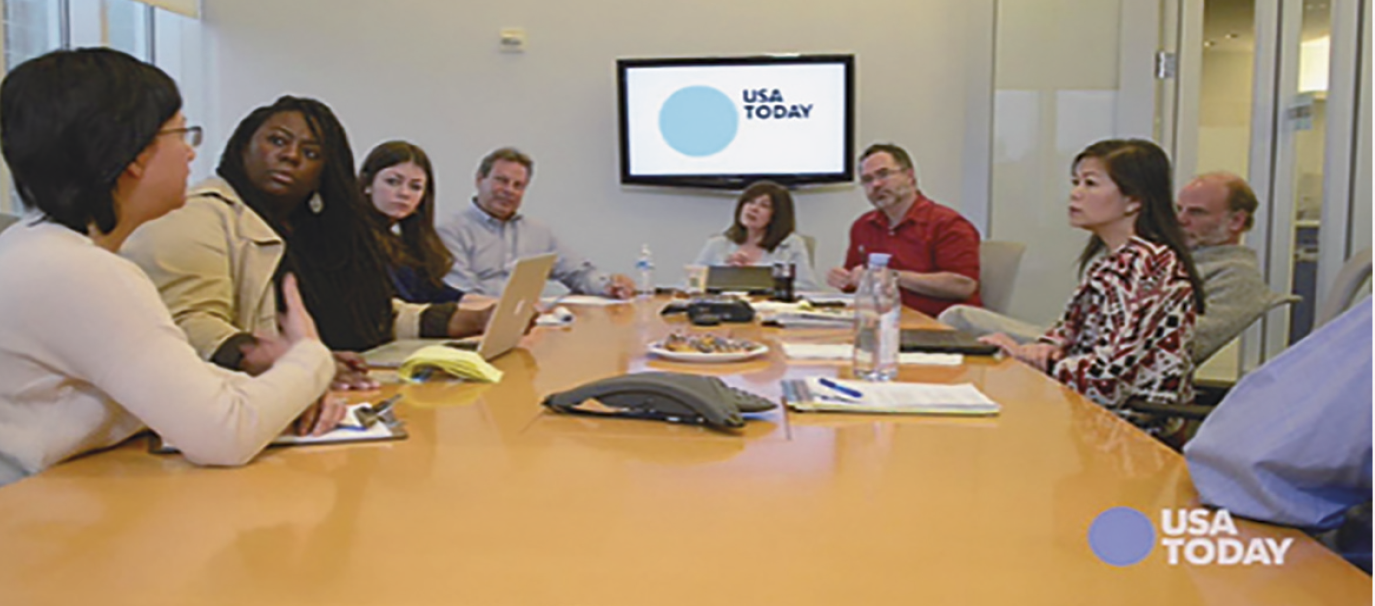
[...] When student protests and the resignation of the university president revealed deep racial problems at the University of Missouri last week, it seemed at first like a singular event.
Since then, it’s become increasingly clear that similar tensions are raging on campuses from Connecticut to California. [...]
CAMPUS Adults, Protect Free Speech: Our View. USA Today, Tysons, 18 novembro 2015. Disponível em: https://oeds.link/Ils40r. Acesso em: 30 abril 2022.
- What is the title of the text? Who wrote it?
b. Is it an opinion text? Explain your answer.
Listening
3. Listen to an expert talking about consequences suffered by people who stood up for their beliefs in considering freedom of speech in the digital era. Order the topics the expert mentions and write the answers in your notebook.

Clique no play e acompanhe a reprodução do Áudio.
- People were trolled online.
- People were forced to move.
- Their personal information was leaked.
- Lies were spread about people.
e. There were threats.
Respostas e comentários
1. Respostas pessoais. Ver Notas.
2. a) The title is “Campus adults, protect free speech: our view”. The Editorial Board of the iu és ei Today wrote it.
2. b) Yes, it is. It is an editorial and the headline reads “our view”.
3. a) 1
3. b) 5
3. c) 3
3. d) 2
3. e) 4
Listening
Trabalha-se a habilidade ê éfe zero nove éle ih zero três: analisar posicionamentos defendidos e refutados em textos orais sobre temas de interesse social e coletivo – por meio de uma mesa redonda sobre liberdade de expressão na era digital.
Transcript: Expressing opinions and reaching a consensus – Threats
In some cases though we’ve seen really really tragic results. For example in Idaho, I’ve had multiple people who, because they stood up against you know against extremists there, then became trolled and had disinformation about them put out over the internet. Had correct information: their names, their photographs, their addresses, where their children go to school. Urging others to come and threaten them and I know of two people alone in just one small town in Idaho who were forced to move. Actually, the place they had lived for more than two decades. To move someplace else because of the constant threats and harassment.
CAN TECH Companies Protect Free Speech in the Information Age?. 2022. 1 vídeo (60métros39segundos). Publicado pelo canal The Atlantic. Disponível em: https://oeds.link/7nhtrA. Acesso em: 4 julho 2022.
4. Listen to another part of the speech and complete the sentences with words used by the specialist. Write the answers in your notebook and write one extra sentence with each word.

Clique no play e acompanhe a reprodução do Áudio.
- That had real world espaço para resposta and I can give you example after example.
- What’s the remedy for espaço para resposta speech or harmful speech?
- We are talking about speech that can end up significantly espaço para resposta people.
5. [Listen to the recording again and answer in your notebook: What is the consequence of hateful speech mentioned by the expert?

6. Listen to Malala talking about differences between developed and underdeveloped areas of the world and discuss with your classmates: What is the role of free speech in a world where some people still suffer the consequences of wars and conflicts?

Clique no play e acompanhe a reprodução do Áudio.
Going further
This is the First Amendment to the u ésse Constitution:
“Congress shall make no law respecting an establishment of religion, or prohibiting the free exercise thereof; or abridging the freedom of speech, or of the press;
McWHIRTER, R. J. The First Amendment: an illustrated history. Tempe, AZ, u ésse: Constitution Press, 2017. página 3.
Is there a similar law in Brazil? Do some research and share the results with your classmates.
Post-listening
- Discuss these questions with your classmates.
- Whose opinions do you agree with? Why?
- Was the debate respectful? uai ór uai nót ?
- How would you feel if you were in a similar debate?
Respostas e comentários
4. a) consequences
4. b) hateful
4. c) harming
5. The consequence of hateful speech mentioned by the expert is that it can actually end up significantly harming people.
6. Resposta pessoal.
Going further. Ver Notas.
Brazilian Constitution’s Article 5 is about freedom of expression.
7. a) Respostas pessoais.
7. b) Respostas possíveis: Yes, because nobody used bad words, nobody offended anybody, they focused on the facts and didn’t mix them with personal situations.
7. c) Resposta pessoal.
Notas
Atividade 5
professor ou professora, sugere-se encorajar os ou as estudantes a se atentarem ao contexto das frases para compreender o significado das palavras. Caso ainda haja dúvidas na produção das frases, permita-lhes acessar dicionários on-line para consultar o significado das palavras. Sugere-se o uso do dicionário disponível em: https://oeds.link/vYrHsa Acesso em: 21 junho 2022.
Atividade 6 professor ou professora, pode-se pedir aos ou às estudantes que compartilhem como ficam sabendo de ocorrências pelo mundo, e discutam a importância da liberdade de expressão para que as informações sobre o que acontece de verdade pelo mundo chegue a mais pessoas. Pode-se também encorajar os ou as estudantes a discutir sobre como avaliam se as informações que recebem são confiáveis ou não.
Transcript: Expressing opinions and reaching a consensus – Consequences
That had real world consequences and I could give you example after example after example of actual real world harm. So, as we get into this discussion about the first amendment, it’s important that we’re not just talking now about speech for speech’s sake or what is the remedy for hateful speech or harmful speech more speech, because we’re talking now about speech that that actually can end up significantly harming people.
CAN TECH Companies Protect Free Speech in the Information Age?. 2022. 1 vídeo (60métros39segundos). Publicado pelo canal The Atlantic. Disponível em: https://oeds.link/rkKdZM. Acesso em: 4 julho 2022.
[Transcript: Expressing opinions and reaching a consensus – World problems
Today in half of the world we see rapid progress and development. However, there are many countries where millions still suffer from the very old problems of war, poverty and injustice. We still see conflicts in which innocent people lose their lives and children become orphans. Why is it that countries which we call strong are so powerful in creating Wars but are so weak in bringing peace?
BEST SPEECH Ever – Malala Yousafzai Speech – Why Is It – Powerful Speech. 2020. 1 vídeo (3métros26segundos). Publicado pêlo canal Great Thought Of My Life. Disponível em: https://oeds.link/F5Nr1n. Acesso em: 4 julho 2022.
Going further
professor ou professora, o trecho da Constituição brasileira que trata de liberdade de expressão é o Artigo 5º. O texto integral está disponível no site oficial da Presidência da República.
ispíquin
A deliberative conversation
Pre-speaking
1. Discuss these questions with your classmates.

- What does the picture show?
- Have you ever been in a situation like this? If so, when and where was it?
- Have you ever been in any type of conversation in which people thought differently from you? If so, who were you talking to and what was it about?
- Do you know any strategies to persuade other people to understand your point of view? If so, which uon ór uons ?
- Generally speaking, in a discussion, are you open to changing your mind when other people use strong arguments? Answer with examples.
- Let’s prepare a deliberation. Follow the instructions.
- Get into groups. Choose a topic that has been in the media recently. Consider a topic that requires suggestions of measures that can be taken to improve the situation or solve the problem.
- Do some research to find out more about it (e.g.: facts, what different people have said about it, problems or issues it may have raised, etcétera).
- Individually, think about the issue and make up your mind about it. Take notes of examples or pieces of information you can use to support your opinion and your proposal.
- Listen to the audio from the “Listening” section again to get ideas of expressions you can use to present your opinion and proposal. These expressions, as well as some others, can also be found in the “Useful language” box.
- Prepare the script for what you want to say. If necessary, use the dictionary or ask your ticher ór clasmeites to help with the words you do not know.
- Practice expressing your views to members of different groups and listen to them as well.
- Make comments about what they said (if the arguments are persuasive, if the solutions are viable, etcétera) and listen to the feedback about your talk. Make changes if necessary.
Respostas e comentários
A legenda da foto foi suprimida do livro do estudante para fins didáticos: Grupo de estudantes debate em uma biblioteca na Ucrânia, 2019.
1. a) Respostas possíveis: A group of teenagers having a discãssion ór dibeiti ór deliberative converseitchion .
1. b) Respostas pessoais.
1. c) Respostas pessoais.
1. d) Respostas pessoais.
1. e) Respostas pessoais.
2. Ver Notas.
Speaking
Esta seção tem por objetivo estimular os ou as estudantes a se engajar em uma reunião/sessão deliberativa. Para isso, solicitar aos ou às estudantes que, em um primeiro momento, se preparem e que, em seguida, se organizem em grupos para deliberar sobre os temas escolhidos. A seção cumpre, portanto, as habilidades ê éfe zero nove éle ih zero um: fazer uso da língua inglesa para expor pontos de vista, argumentos e contra-argumentos, considerando o contexto e os recursos linguísticos voltados para a eficácia da comunicação; e ê éfe zero nove éle ih zero três analisar posicionamentos defendidos e refutados em textos orais sobre temas de interesse social e coletivo.
professor ou professora, se considerar relevante, apresentar aos ou às estudantes a diferença entre uma deliberação, que é a proposta de produção oral desta unidade, e um debate. Em um debate, há oposição de ideias e cada lado procura os pontos frágeis do oponente, ao passo que, em uma deliberação, as partes envolvidas procuram os pontos fortes tanto de um lado como do outro; em um debate, procura-se enfatizar as diferenças, enquanto uma deliberação envolve a busca do equilíbrio entre opiniões diferentes. Em suma, em um debate, o objetivo principal é vencer a disputa de ideias procurando provar que o outro não tem razão, ao passo que, em uma deliberação, há colaboração e a tentativa de alcançar um entendimento em comum.
Notas
Atividade 2 a professor ou professora, como alternativa, pode-se restringir esta produção oral a um único tópico. Por exemplo, os ou as estudantes podem se engajar em uma reunião/sessão deliberativa acerca do limite (se deve haver algum) para a liberdade de expressão e do que pode ser (ou não) considerado liberdade de expressão no contexto de nossa sociedade.
Useful language
|
Asking for opinion |
Expressing opinion |
Filler words |
Agreeing |
Disagreeing |
Conceding |
|---|---|---|---|---|---|
|
What do you think…? Is everybody on board with…? |
One conclusion I’ve come to is that… There are a few facts that we have to keep in mind… I think… It’s about… |
I mean… Right… You know… |
I agree with you that… Fair enough. You earned a point. |
But again,… I understand your point, but... That’s true, but... |
If… was just about…, then I would agree with you. As long as… |
Speaking
- You are going to engage in a deliberative conversation.
- Get together with the members of your group.
- Decide who is going to mediate the conversation. The mediator should take notes on what the other members of the group are saying and make sure everyone respects each other's opinions and turns speaking.
- In turns, express your views, saying if you agree or disagree with your classmates’ views.
- After everybody has presented their case, the mediator must summarize the opinions and check if everybody agrees with the views that resulted from the deliberative conversation.
Post-speaking
- Discuss these questions with your classmates.
- Did you tend to agree or disagree with your classmates’ opinions?
- How difficult was it to express your opinion?
- Did you try not to take opposing views personally? How important is it to do that?
- How do you evaluate this activity? How can it be useful to you in the present or in the future?
Going further
After this conversation, research more about the opposing views mentioned. Has your opinion changed after doing this research? If not, why? If so, how would this change the arguments you presented?
Respostas e comentários
Useful language. Ver Notas.
4. Respostas pessoais.
Going further. Respostas pessoais.
Useful language
professor ou professora, sugere-se reproduzir novamente o áudio para que os ou as estudantes tenham novamente contato com algumas das expressões do boxe em contexto. Recomenda-se reforçar que algumas dessas expressões foram retiradas do áudio trabalhado na seção “Listening” e são um pouco mais formais, sendo bastante utilizadas tanto no mundo dos negócios como no meio acadêmico – motivo pelo qual é importante que os ou as estudantes tenham contato com elas e as utilizem em sua discussão.
Acompanhando a aprendizagem
professor ou professora, para estimular os ou as estudantes a pensar sôbre os temas (ou tema, caso tenha optado por restringir a produção a um único assunto), pode-se trazer algumas manchetes e até mesmo editoriais de jornais locais. Pode-se discutir essas matérias de maneira a conduzir os ou as estudantes a se posicionar criticamente a respeito do que elas abordam. Sugere-se sempre enfatizar a importância do respeito que se deve ter às opiniões divergentes. Com base nesses conteúdos e nas discussões, espera-se que os ou as estudantes consigam desenvolver seus trabalhos com mais fundamentação e segurança.
fóra da sala de aula
professor ou professora, como os ou as estudantes já tiveram, até aqui, oportunidade de ler editoriais, ouvir o áudio de uma reunião editorial e, nesta seção, de participar de uma reunião deliberativa, pode-se enconrajá-los ou encorajá-las a procurar saber mais sobre o funcionamento de um jornal. Se for possível, organizar uma visita à séde de um jornal local ou convidar algum ou alguma jornalista da área para dar uma palestra para a turma. os ou as estudantes poderão, assim, comparar o processo de escolha da pauta no editorial do iu és ei Today (seção “Listening”) com o que acontece no jornal que tiverem visitado ou no qual trabalha o ou a jornalista convidado ou convidada. Pode-se realizar esta atividade em parceria com a disciplina de Língua Portuguesa.
ráitin An editorial
How about preparing an editorial about a pressing issue in your community?
What: an editorial
To whom: other students; people in general
Media: paper; digital
Objective: present an opinion about an issue that is relevant to your community

Pre-writing (brainstorming)
- In groups, list some recent controversial issues that have been grabbing your community’s attention. Choose one of them to investigate. Consult print or online papers, talk to school/community/family members, etcétera to collect facts and opinions on the issue.
- Decide on your position about this issue: Whose views are you going to support? Why? Are you going to offer a fresh look onto the topic? If so, how will you do that?
- Choose the pieces of information you are going to use to set the context for the editorial and to help you build your argument. Organize the data you collected according to viewpoints.
- Pick some quotations that offer evidence to back up your opinion.
First draft
5. Review the characteristics of editorials in the “Reading” section and write the first draft of your text. Tips: Provide a summary of the issue you are focusing on and state your opinion briefly in the first paragraph. Explain each opposing viewpoint first with facts and quotations. Refute these opposing views and express your opinion with facts, figures, quotations, etcétera Mention the good points in the opposing views (if any) and say why you agree with them. This helps your text seem more rational. If possible, suggest solutions. Encourage critical thinking and proactive reaction. Write a conclusion that restates your point of view from the introduction.
Editing
6. Show your draft to other groups. Ask them if the arguments make sense and if the opinion is clear. Listen to their comments and make changes if necessary.
Final text
7. Pin the final version of your editorial up on the classroom board for your classmates to read.
Post-writing
8. Discuss the editorials and the suggestions provided by each of them. Can these suggestions be put into practice?
Respostas e comentários
1. Ver Notas.
8. Ver Notas.
Writing
O objetivo desta seção é convidar os ou as estudantes a escrever um editorial. Na seção são cumpridas as seguintes habilidades: ê éfe zero nove éle ih zero nove: compartilhar, com os colegas, a leitura dos textos escritos pelo grupo, valorizando os diferentes pontos de vista defendidos, com ética e respeito; ê éfe zero nove éle ih um zero: propor potenciais argumentos para expor e defender ponto de vista em texto escrito, refletindo sobre o tema proposto e pesquisando dados, evidências e exemplos para sustentar os argumentos, organizando-os em sequência lógica; ê éfe zero nove éle ih um dois: produzir textos (infográficos, fóruns de discussão on-line, fotorreportagens, campanhas publicitárias, memes, entre outros) sobre temas de interesse coletivo local ou global, que revelem posicionamento crítico– com foco na produção de editoriais.
Notas
Item 1
professor ou professora, para estimular a turma a pensar sobre as questões que têm chamado a atenção de sua comunidade, pode-se trazer algumas manchetes, editoriais de jornais locais, de jornais on-line ou materiais audiovisuais, se existirem. Recomenda-se, então, discutir algumas dessas questões para que os ou as estudantes consigam desenvolver um posicionamento crítico mais embasado. Ao final, pode-se registrar no quadro algumas considerações importantes após essa discussão prévia. Espera-se que essa preparação contribua para que os ou as estudantes selecionem melhor os tópicos que vão explorar em seus editoriais.
Item 8 professor ou professora, caso a escola publique algum jornal, impresso ou on-line, pode-se considerar a possibilidade de incluir todas ou algumas das produções dos/as estudantes nesse meio. Outra possibilidade, dependendo das produções da turma, é considerar a viabilidade de submeter as propostas dos/as estudantes para algum órgão local com poder de decisão, como a câmara de vereadores, a secretaria regional ou municipal ou um site de petição on-line etcétera
pici cãltchur
Read the following text and answer the questions.

THE COVER of George Orwell’s 1984 Becomes Less Censored with Wear and Tear. Open Culture, [sem local], 2016. Disponível em: https://oeds.link/aqjmtx Acesso em: 22 março 2022.
In 2013, Penguin released […] a series of new covers for five works by George Orwell, including a particularly bold cover design for Orwell’s best-known work, 1984. […] No doubt, the design plays on the whole idea of censorship, “referencing the rewriting of history carried out by the novel’s Ministry of Truth.”
[…] But anyone with a well-worn copy of the book might discover […] that the cover design “becomes less censored with wear.”
- What was the purpose of hiding the book’s title and author? Was it censorship?
- Research about works of art that were censored in Brazil or overseas. Why were they banned?
selfi-tchéqui
1. Go over Unit 8, as well as your answers and notes in your notebook. Then choose the options that best assess your achievements and write them in your notebook.
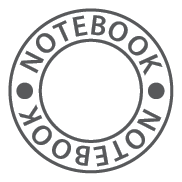
|
I can... |
|
|
|
|---|---|---|---|
|
understand an editorial... |
|||
|
understand and use conditional sentences (type 2) to talk about hypothetical situations under a certain condition... |
|||
|
understand the meaning and use of internet language... |
|||
|
understand a deliberative session of an editorial board... |
|||
|
take part in a deliberative conversation/ session... |
|||
|
write an editorial... |
Respostas e comentários
1. The title of the book and its author’s name (George Orwell) were obscured to reference one of the main themes of the narrative: censorship. Therefore, it was not censorship; rather, it was a creative marketing strategy.
2. Respostas pessoais.
Self-check. Respostas pessoais.
Self-check
professor ou professora, espera-se que cada estudante use esta seção para avaliar o seu aprendizado ao longo da unidade, a fim de identificar com quais itens teve facilidade, alguma facilidade e dificuldade, e, se necessário, com sua ajuda, organizar um plano de ação sobre como pode melhorar o próprio aprendizado e como pode auxiliar os ou as colegas.
Acompanhando a aprendizagem
professor ou professora, para cada item do “Self-check”, há uma sugestão de encaminhamento de trabalho para os ou as estudantes com dificuldade. Sugere-se que os estudantes:
- releiam/refaçam as atividades na seção “rídin” e busquem outros editoriais em jornais e revistas confiáveis.
- revejam as informações na seção “lenguage in iusi uon” e no apêndice “lenguage réference in contécsti ”.
- revejam a atividade 5 da seção “lenguage in iusi tchu” e refaçam os cuízes criados pela turma na atividade 6 da mesma seção.
- ouçam o áudio da seção e acompanhem com a leitura da transcrição disponível no final do livro. Em uma segunda audição, ouçam o áudio sem o apoio da transcrição. Para compreender detalhes de pronúncia, pode-se acessar o linque de onde o áudio foi extraído e reproduzi-lo com velocidade reduzida.
- ouçam o áudio da seção “lissenin”, tomem notas da dinâmica das falas e registrem expressões úteis para introduzir uma opinião, uma concordância etcétera, tendo como referência o boxe “uisiful ” da seção “ispíquin”.
- voltem à seção “rídin” para observar as características de um editorial e rever o passo a passo na seção “ráitin”. Pode-se, então, escrever um editorial sobre um tema menos complexo, baseado em editoriais tanto em inglês como em português.
bí en eigientchi ófi tchéngi Units 7 and 8 Agree to disagree
1. There is a fine line between free speech and hate speech. You may be free to express yourself, but you should do it respectfully, without harming anyone. Based on this first consideration, read the texts and talk to a classmate about the following questions.
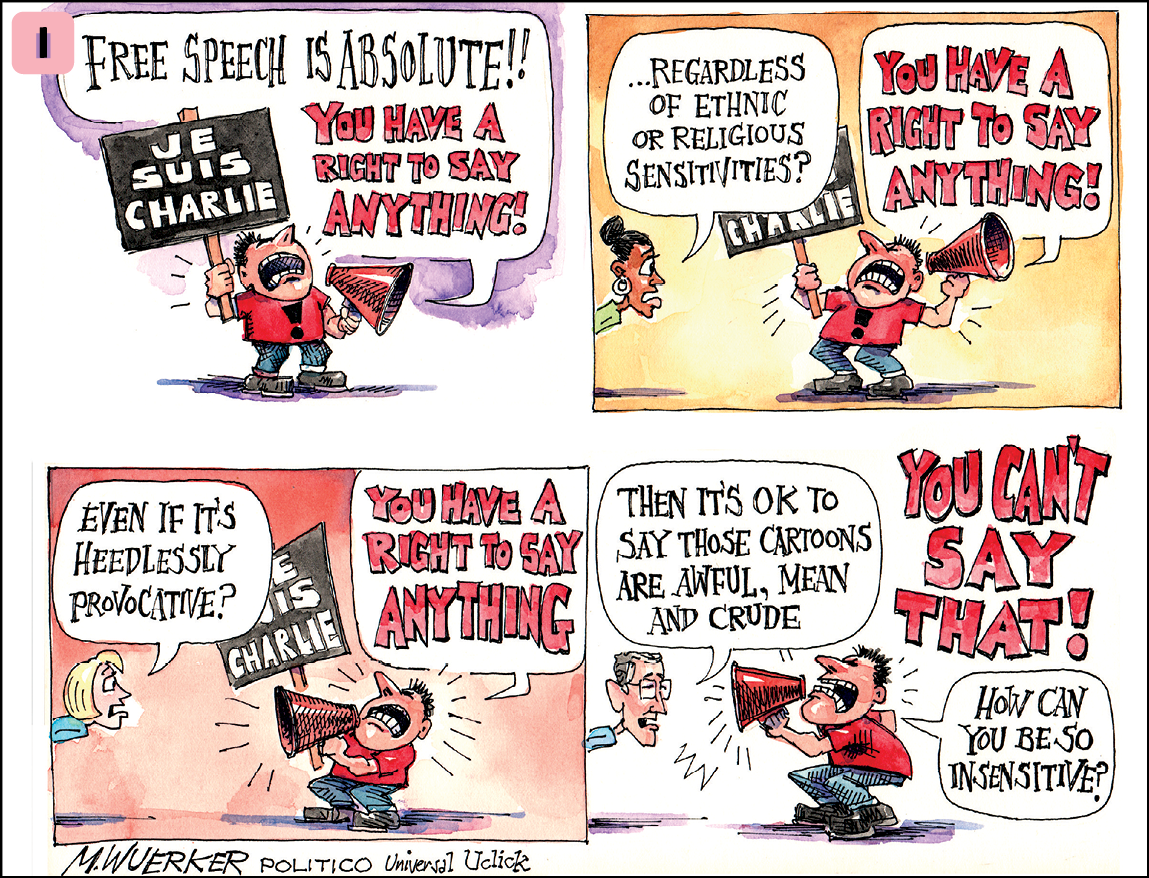

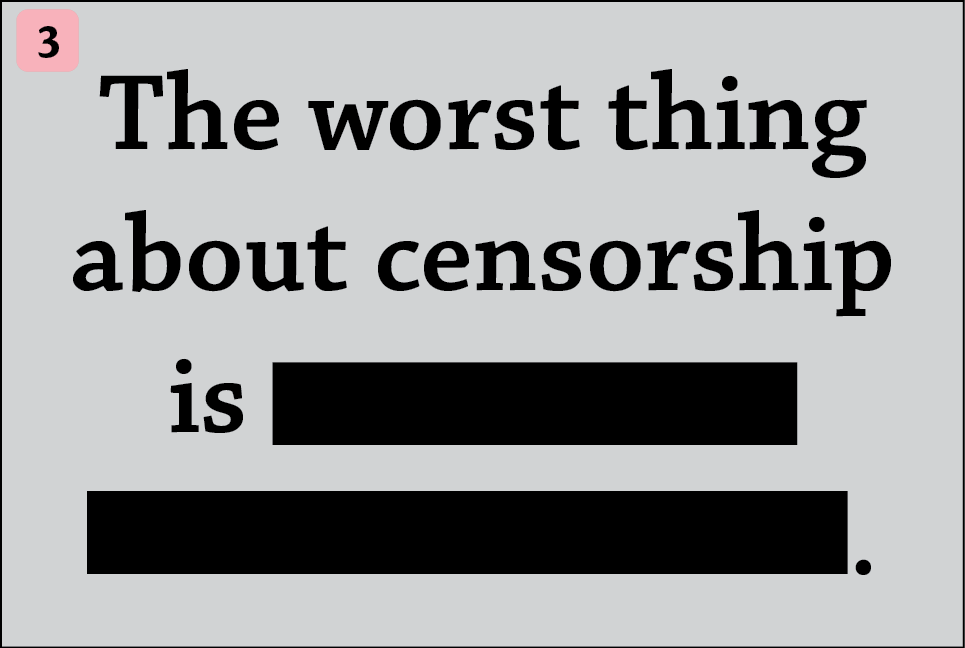
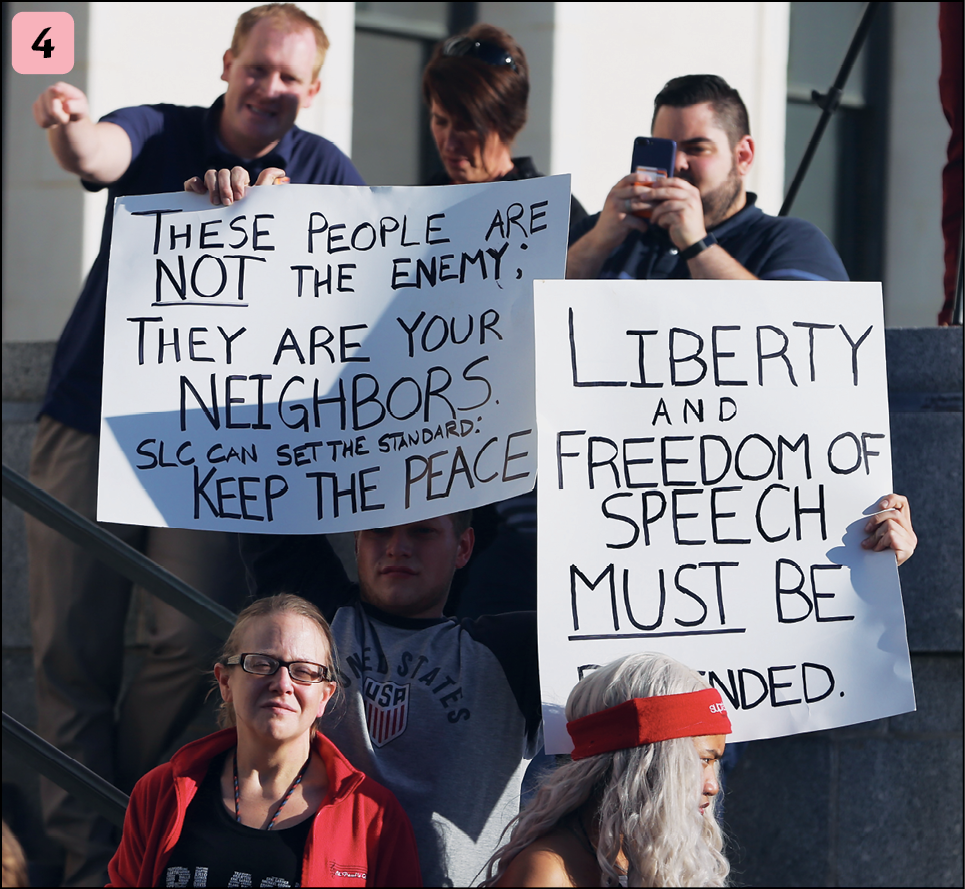
- What topic do texts 1 and 2 have in common? Explain your answer.
b. How do you interpret the message in text 3? How is it different from the message in text 4?
Respostas e comentários
1. a) Respostas possíveis: The irony about the freedom of speech. In text 1, the man says he is in favor of free speech even if it offends someone, but he is against free speech if it offends him. In text 2, the irony lies in the fact that a text produced to express someone’s opinion was probably altered by the editors.
1. b) Respostas possíveis: In text 3, someone who is trying to talk about censorship is censored, probably by a person who doesn’t agree with him ór her. It contrasts with the opinion expressed in text 4, in which one supports the idea that liberty and free speech must be defended.
Be an agent of change
• Agree to disagree
Esta seção toma por base as seguintes competências do item Competências Gerais da Educação Básica da Bê êne cê cê (BRASIL, 2018, página 9 e 10): “4. Utilizar diferentes linguagens – verbal (oral ou visual-motora, como Libras, e escrita), corporal, visual, sonora e digital –, bem como conhecimentos das linguagens artística, matemática e científica, para se expressar e partilhar informações, experiências, ideias e sentimentos em diferentes contextos e produzir sentidos que levem ao entendimento mútuo.”, “7. Argumentar com base em fatos, dados e informações confiáveis, para formular, negociar e defender ideias, pontos de vista e decisões comuns que respeitem e promovam os direitos humanos, a consciência socioambiental e o consumo responsável em âmbito local, regional e global, com posicionamento ético em relação ao cuidado de si mesmo, dos outros e do planeta.” e “9. Exercitar a empatia, o diálogo, a resolução de conflitos e a cooperação, fazendo-se respeitar e promovendo o respeito ao outro e aos direitos humanos, com acolhimento e valorização da diversidade de indivíduos e de grupos sociais, seus saberes, identidades, culturas e potencialidades, sem preconceitos de qualquer natureza.”. Sob tais perspectivas, busca-se conscientizar os ou as estudantes sobre a tênue linha que há entre a liberdade de expressão e o discurso de ódio, bem como sobre a importância de desenvolver habilidades que permitam expressar, de modo respeitoso, discordância de opiniões alheias. A seção desenvolve as habilidades ê éfe zero nove éle ih zero um: fazer uso da língua inglesa para expor pontos de vista, argumentos e contra-argumentos, considerando o contexto e os recursos linguísticos voltados para a eficácia da comunicação; e ê éfe zero nove éle ih um quatro: utilizar conectores indicadores de adição, condição, oposição, contraste, conclusão e síntese como auxiliares na construção da argumentação e intencionalidade discursiva – contempladas na atividade 5.
Notas
Atividade 1 professor ou professora, se necessário, esclarecer que a frase “Je suis Charlie” faz referência ao jornal satírico frânces Charlie Hebdo, cuja redação foi vítima de um atentado terrorista em 7 de janeiro de 2015. O motivo alegado para o atentado foram as representações caricaturais que ofenderam uma parcela muçulmana da população. A frase em questão foi replicada por todos/as que se solidarizaram com o jornal.
2. “Agree to disagree” is the title of this section. What does this expression mean? Read the useful phrases below to help you come up with an answer.
I’m afraid I disagree with you there.
I’m sorry, I disagree with you there.
I’m not sure that’s always true.
I’m not sure I agree with you there.
I’m not convinced that’s the case.
- In your daily life, do you use the “agree to disagree” skills to manage conflicts? How important is it to develop such skills? Do you think it contributes to building a culture of peace?
- Read this statement made by one of South Africa’s most well-known human rights activists. Then discuss the questions with a classmate.
“Don’t raise your voice, improve your argument.”
Desmond Tutu
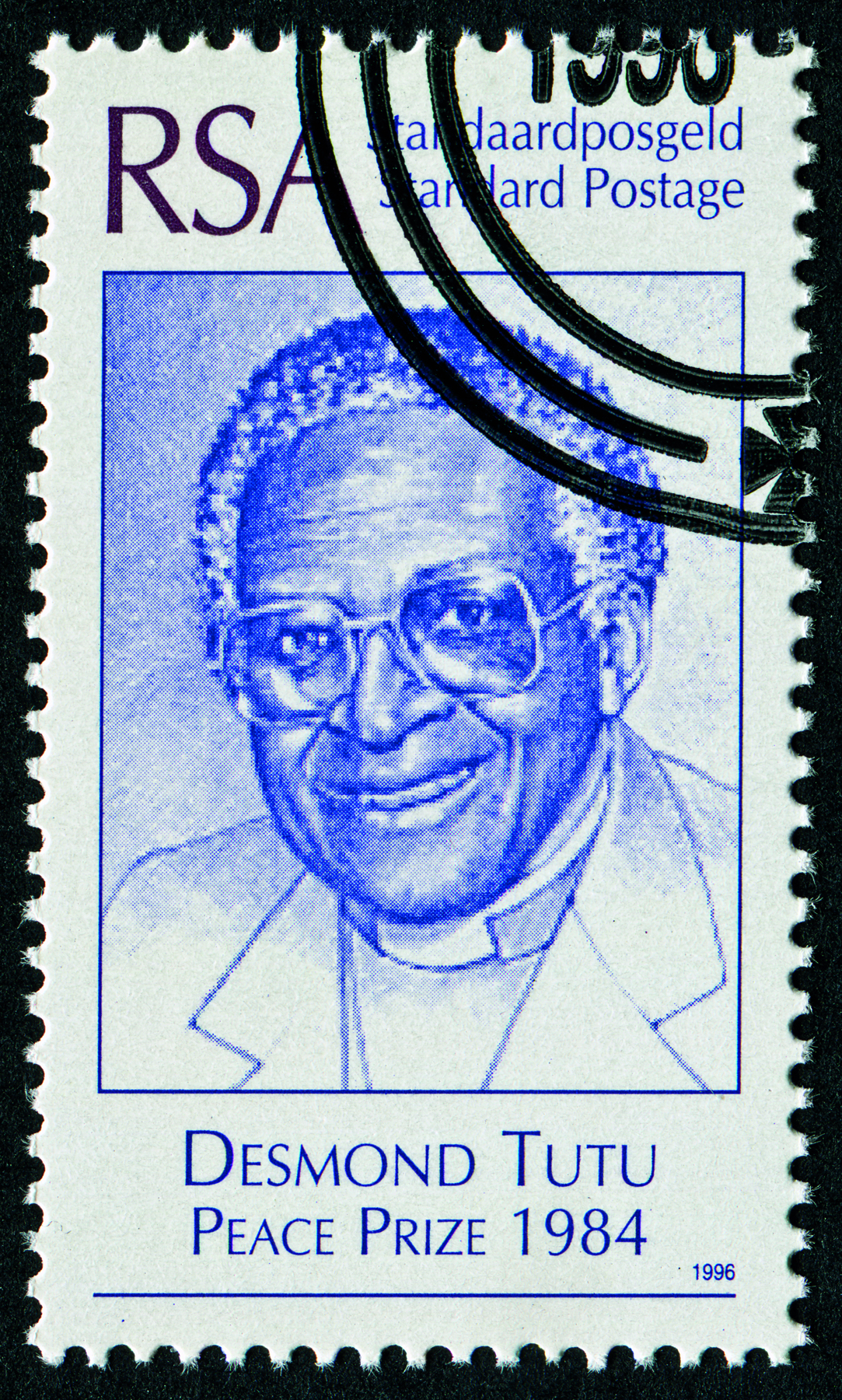
- Do you agree with Desmond Tutu? Explain your answer.
- How can we communicate better? What can or cannot be said or done to defend an argument?
- Have a round-table discussion practicing the “agree to disagree” skills. Follow the instructions.
- Choose one of the topics below to discuss. You can think of different topics as well.
being able to choose your school subjects making your own food
using the smartphone in class wearing uniforms to school
- Organize yourselves into two groups, one in favor of the topic and the other one against it. Make a list of arguments to be used in order to defend your position.
- Ask the teacher or a student to mediate the debate. Start the round-table discussion.
d. Remember to use the appropriate linking words (connectors) whenever possible in your arguments.
Respostas e comentários
2. Respostas possíveis: It is a polite way to express the idea that someone disagrees with what someone else has said or written. In other words, it is a good strategy to handle conflicts by listening to someone else’s positions without agreeing with them.
3. Respostas pessoais.
4. Ver Notas.
4. a) Respostas pessoais.
4. b) Respostas possíveis: Opinions could be based on facts or examples, but should not be taken at face value. Any attitude or expression that is against the human rights should be avoided, such as violence or prejudice.
5. d) Ver Notas.
Notas
Atividade 4 professor ou professora, pode-se informar que a frase “Don’t raise your voice, improve your argument” (“Não levante a voz, melhore seu argumento”) foi dita pelo ativista sul-africano Desmond Tutu durante um discurso que proferiu na Fundação Nelson Mandela, em Joanesburgo, África do Sul, em 2004.
Atividade 5 d professor ou professora, se necessário, revisar o tópico da seção “Language in use 2” (connectors/linking words) da Unidade 7 deste volume, visto que esse recurso linguístico pode ser útil na formulação das argumentações.
Informações adicionais
Desmond Tutu (1931-2021): religioso sul-africano envolvido na luta pelos direitos civis para todos em seu país. Sua posição segura contra o regime do apartheid lhe valeu, em 1984, o Prêmio Nobel da Paz.
Acompanhamento da aprendizagem
professor ou professora, caso sinta necessidade de adaptar a atividade 5 para auxiliar os ou as estudantes com maior dificuldade, pode-se elaborar, de antemão, alguns argumentos a favor e outros contra e registrá-los no quadro, aleatoriamente. Desse modo, os ou as estudantes só teriam que avaliar cada tópico proposto e escolher, entre as ideias no quadro, aquelas que mais se aproximem de suas posições. enconrajá-los ou encorajá-las a personalizar seus argumentos e evitar reproduzi-los tais como estão no quadro. Algumas sugestões para o primeiro tópico [(“being able to choose your school subjects”):
In favor: We can study only the things we enjoy./We can have better results./We can be more motivated./We don’t study under pressure./We feel that what we study makes sense.; Against it: We don’t have enough maturity to choose what is best for us./We may not be challenged to learn new things./We get used to do only what we enjoy./We may choose things that are not so relevant to learn.
Glossário
- censorship
- – censura
- Voltar para o texto